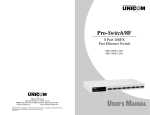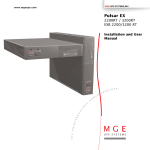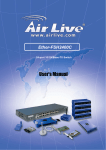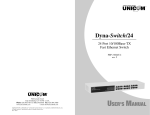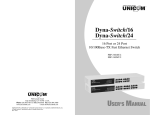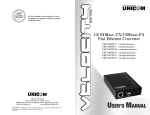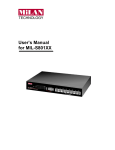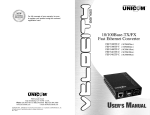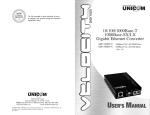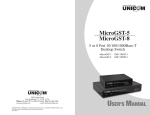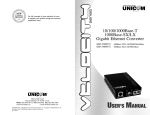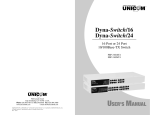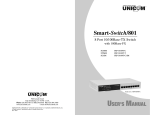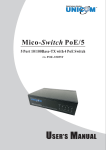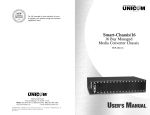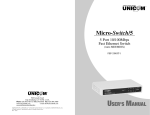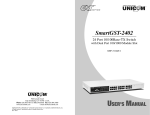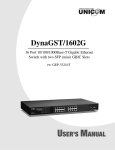Download UNICOM FEP-32024T Specifications
Transcript
Micro-Switch/24 24 Port 10/100Mbps Desktop Fast Ethernet Switch (Auto MDI/MDIX) FEP-32024T 908 Canada Court City of Industry, CA 91748 U.S.A. Phone: 626.964.7873 or 800.346.6668 Fax: 626.964.7880 www.unicomlink.com www.unihomenetworkingbox.com e-mail: [email protected] ©UNICOM 2005. UNICOM and “A Network Systems Solution” are trademarks of UNICOM Electric, Inc. All rights reserved. Specifications subject to change without notice. Rev: 01.05 USER’S MANUAL Content 1. Introduction .............................................................. 1 Features ...................................................................... 1 Package Contents...................................................... 2 Ethernet Switching Technology............................... 3 2. Hardware Description.............................................. 4 Front Panel ................................................................. 4 LED Indicators............................................................ 4 Rear Panel................................................................... 5 Desktop Installation................................................... 6 3. Network Application ................................................ 7 4. Troubleshooting..................................................... 10 5. Technical Specification ......................................... 12 1. Introduction The 24 Port Micro-Switch/24 Desktop Fast Ethernet Switch is a multi-port Switch that can be used to build high-performance switched workgroup networks. This switch is a store-and-forward device that offers low latency for high-speed networking. It is targeted at workgroup, department, or backbone computing environments in SME (small, medium enterprise) businesses. The Micro-Switch/24 features a “store-and-forward “switching scheme. This allows the switch to auto-learn and store source addresses on a 4K-entry MAC address table. Features Conforms to IEEE 802.3, 802.3u and 802.3x Twenty-four (24) 10/100 Base-TX RJ-45 Ethernet ports Auto-MDIX on all ports IEEE 802.3x flow control support Flow control on full-duplex Back pressure on half-duplex N-Way Auto-Negotiation supported Store-and-Forward switching architecture and no-blocking full wire speed Back plane Bandwidth 4.8 Gbps) Embedded 1.25Mbits memory buffer 4K MAC address table Compact 10” size 1 Package Contents Unpack the contents of the Micro-Switch/24 Desktop Fast Ethernet Switch and verify them against the checklist below. Micro-Switch/24 Desktop Fast Ethernet Switch User Guide Power Cord Four Rubber Feet Micro-Switch/24 User Guide Power Cord Rubber Feet Figure 1-2. Package Contents Compare the contents of your Micro-Switch/24 package with the standard checklist above. If any item is missing or damaged, please contact your local dealer for service. 2 Ethernet Switching Technology Ethernet Switching Technology dramatically boosted the total bandwidth of a network, eliminated congestion problems inherent with Carrier Sense multiple access with Collision Detection (CSMA/CD) protocol, and greatly reduced unnecessary transmissions. This revolutionized networking in a number of ways. First, by allowing twoway, simultaneous transmissions over the same port (Full-duplex) which essentially doubled the bandwidth. Second, by reducing the collision domain to a single switch-port which eliminated the need for carrier sensing. Third, by using the store-and-forward technology’s approach of inspecting each packet to intercept corrupt or redundant data and switching eliminated, unnecessary transmissions that slow the network. Also employing an address learning function, Ethernet replaced inefficient receiving ports. Auto-negotiation regulates the speed and duplex of each port, based on the capability of both devices. Flow-control allows transmission from a 100Mbps node to a 10Mbps node without loss of data. Auto-negotiation and flowcontrol may require disablement of some networking operations that involve legacy equipment. Disabling the auto-negotiation is accomplished by manually setting the speed or duplex of a port. Ethernet Switching Technology supplied higher performance at costs lower than other solutions. Wider bandwidth, no congestion, and the reduction in traffic is why switching is replacing expensive routers and inefficient hubs as the ultimate networking solution. Switching brought a whole new way of thinking to networking. 3 2. Hardware Description This Section describes the hardware of the Micro-Switch/24 Desktop Fast Ethernet Switch/. The physical dimensions of the Micro-Switch/24 are: 250mmx 133 mm x 37mm (L x W x H) Front Panel The Front Panel of the Micro-Switch/24 consists of twenty-four (24) 10/100Base-TX RJ-45 ports. The LED Indicators are also located on the front panel of the Switch. Figure 2-1. The Front panel RJ-45 ports (Auto MDI/MDIX): Twenty-four (24) 10/100Mbps auto-sensing ports for 10Base-T or 100Base-TX device connection. [Auto MDI/MDIX means that you can connect to another switch or workstation with either straight-through or crossover cabling.] LED Indicators The LED Indicators gives real-time information of systematic operation status. The following table provides descriptions of LED status. 4 Figure 2-2. LED Indicators LED Power LK/ACT Status Description Green Power is supplied Off Power is not connected Green The port is connecting with the device Blinks The port is receiving or transmitting data Off No device attached Table 2-1. Descriptions of LED Indicators Rear Panel The 3-pronged power plug is located at the rear panel of the Micro-Switch/24 as shown in Figure 2-3. The Switch will work with AC in the range 100-240V AC, 50-60Hz. Figure 2-3. The Rear Panel of the Micro-Switch/24 5 Desktop Installation Set the Switch on a sufficiently large flat space with a power outlet nearby. The surface should be clean, smooth, level, and sturdy. Ensure there is enough clearance around the Switch to allow air circulation and the attachment of the power cord and cables. Attaching Rubber Feet A. Make sure mounting surface on the bottom of the Switch is grease and dust free. B. Remove adhesive backing from your Rubber Feet. C. Apply the Rubber Feet to each corner on the bottom of the Switch. These footpads protect the Switch from shock and vibration. Figure 2-4. Attaching Rubber Feet to each corner on the bottom of the Switch Power On Connect the power cord to the power socket on the rear panel of the Switch. The other side of power cord connects to the power outlet. The internal power supply in the Switch works with AC in the voltage range 100-240VAC, frequency 50~60Hz.Check the power indicator on the front panel to ensure that power is properly supplied. 6 3.Network Application This section provides a few samples of network topology in which the Switch is used. In general, the Micro-Switch/24 Desktop Fast Ethernet Switch is designed as a segment switch. That is, with its large address table (4K MAC address) and high performance, it is ideal for interconnecting networking segments. You can also use the Micro-Switch/24 to connect PCs, workstations, and servers to each other by connecting these devices directly to the Switch. The switch automatically learns node addresses, which are subsequently used to filter and forward all traffic based on the destination address. The Switch can connect with another switch or hub to interconnect each of your small, switched workgroups to form a larger switched network. Small Workgroup The Micro-Switch/24 can be used as a standalone switch to which personal computers, servers, and printer servers are directly connected to form a small workgroup. Figure 3-1. Small Workgroup Application 7 Segment Bridge For enterprise networks where large data broadcasts are constantly processed, this switch is an ideal solution for department users to connect to the corporate backbone. In the illustration below, two Ethernet switches with PCs, a print server, and a local server are both connected to the Micro-Switch/24. All devices in this network can then communicate with each other through the Micro-Switch/24. Connecting servers to the Switch allow other users to access the server’s data. Figure 3-2 Department Bridge Application 8 4.Troubleshooting This section is intended to help you solve the most common problems on the Micro-Switch/24 Incorrect connections Faulty or loose cables Look for loose or obviously faulty connections. If they appear to be OK, make sure the connections are snug. If this does not correct the problem, try a different cable. Non-standard cables Non-standard and miswired cables may cause numerous network collisions and other network problems that can seriously impair network performance. A Category 5 cable tester is a recommended tool for every 100Base-T network installation. Improper Network Topologies It is important to make sure that you have a valid network topology. Common topology faults include excessive cable length and too many repeaters (hubs) between end nodes. In addition, you should make sure that your network topology contains no data path loops. Between any two end nodes, there should be only one active cabling path at any given time. Data path loops will cause broadcast storms that will severely impact your network performance. 9 Diagnosing LED Indicators The Switch can be easily monitored through panel indicators to assist in identifying common problems you may encounter and where you can find possible solutions. If the power indicator does not turn on when the power cord is plugged in, you may have a problem with power cord. Than check for loose power connections, power losses, or surges at power outlet. If you still cannot resolve the problem, contact your local dealer for assistance. Cabling RJ-45 ports: Use unshielded twisted-pair (UTP) or shielded twistedpair ( STP ) cable for RJ-45 connections: 100m. Category 3, 4, or 5 cable for 10Mbps connections or 100m. Category 5/5e cable for 100Mbps connections. Also be sure that the length of any twisted-pair connection does not exceed 100 meters ( 328 feet ). 10 5.Technical Specification Standard IEEE 802.3 10Base-T Ethernet, IEEE 802.3u 100Base-TX Fast Ethernet IEEE802.3x Flow Control and Back-pressure Protocol CSMA/CD Technology Store and Forward switching architecture Transfer Rate 14,880 pps Ethernet port 148,800 pps Fast Ethernet port MAC address 4K Mac address table Memory Buffer 1.25Mbits 10Base-T: 2-pair UTP/STP Cat. 3/4/5 cable Network Cable EIA/TIA-568 100-ohm (up to 100m) 100Base-TX: 2-pair UTP/STP Cat. 5/5e cable EIA/TIA-568 100-ohm (up to 100m) LED Indicators Back-plane Dimensions Per port: Link/Activity Per unit: Power 4.8Gbps 250mmx 133 mm x 37mm (L x W x H) 9.85" x 4.45" x1.46" Operational Temp. O˚ to 45˚ C (32˚ to 113˚ F) Operational Humidity 10% to 90% (Non-condensing) Power Supply 100-240 VAC, 50~60Hz 11 Power Consumption EMI 19 Watts (maximum) FCC Class A, CE 12















